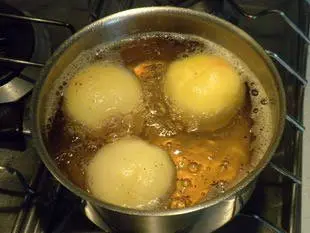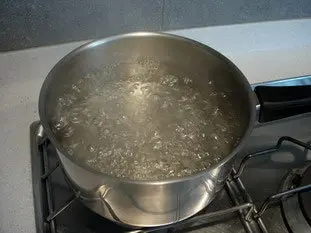This site uses only a few technical cookies necessary for its operation. By continuing to browse, you accept their use.
To find out more...
To find out more...
Sugar syrups
A syrup is simply water and sugar, brought to a boil to mix them well, and then left to cool before use.
The difference is in the ratio of water to sugar, or in other words, how much sugar do you put in how much water?
Of course, starting with 1 liter of water, all weights of sugar are possible, but there are still 2 main proportions very used.
It is used as a base for fruit sorbets, to soak babas or cookies, or to shine the top of a pastry or pastry.
It is used to poach fruits.
Syrups can be kept in a closed container in the fridge, away from the air. They can also be easily frozen.
In summary: A syrup is a mixture of water and sugar in variable proportions, the 2 most used proportions are 1 liter of water for 1 kg of sugar (heavy syrup) or 1 liter of water for 500 gr of sugar (light syrup).
The difference is in the ratio of water to sugar, or in other words, how much sugar do you put in how much water?
Of course, starting with 1 liter of water, all weights of sugar are possible, but there are still 2 main proportions very used.
The heavy syrup
It is a ratio of half and half, 1 liter of water + 1 kilo of sugar. The syrup obtained, quite thick, is called "syrup at 30" by pastry chefs.It is used as a base for fruit sorbets, to soak babas or cookies, or to shine the top of a pastry or pastry.

The light syrup
It is a different ratio, 1 liter of water + 500 gr of sugar. The syrup obtained, quite light, is called "syrup for 60" or "poaching syrup" by pastry chefs.It is used to poach fruits.

How to make it?
It's very simple, you mix sugar and water in the desired proportions in a saucepan, you bring it to boil for 1 minute, you let it cool and it's ready.Syrups can be kept in a closed container in the fridge, away from the air. They can also be easily frozen.
The degree of a syrup
As indicated above, the names sometimes refer to a degree, for example 30° for "syrup at 30", it is not a temperature, but an old measure of concentration, the Baumé degree (of the French chemist Antoine Baumé), which is obsolete but whose use, very approximate, still persists.In summary: A syrup is a mixture of water and sugar in variable proportions, the 2 most used proportions are 1 liter of water for 1 kg of sugar (heavy syrup) or 1 liter of water for 500 gr of sugar (light syrup).
Lasts posts
Butter vs. grease
We often read in a recipe where a pastry is put into a mould that, just before pouring, the mould should be buttered or greased. But what's the difference between these 2 terms?December 1st 20258635
Getting out of the fridge early
Very often when you're cooking, you need to take food or preparations out of the fridge, to use them in the recipe in progress. There's nothing tricky about this: you just take them out of the fridge and use them, usually immediately, in the recipe. But is this really a good method?November 24th 20251,0395
Who's making the croissants?
When you look at a bakery from the outside, you naturally think that in the bakery, the bakers make the bread, and in the laboratory, the pastry chefs make the cakes. It's very often like that, with each of these professions having quite different ways of working, but sometimes there's also one...November 23th 2025935
Oven height
When we put a dish or cake in the oven, we naturally tend to put it on the middle shelf, and that's what we usually do. But in some cases, this position and height can be a little tricky, so let's find out why.October 8th 20252,5825
The importance of sieving
In recipes that use a fine powder (flour, powdered sugar, etc.), you'll often see the advice to sift before using it. To sift is to pass the powder in question through a sieve (a very fine strainer) before incorporating it into your recipe. It's often advice, but is it really useful?September 3rd 20257,4373
Other pages you may also like
Tranché, dissociated, failed, in short... missed!
When preparing a sauce or a cream, there's always a (small) risk that the creamy preparation you're working on will suddenly separate into two parts of different textures: a liquid part, for example, and a more or less solid part, or even become lumpy. It's terribly frustrating, but we'll see...June 19th 202313 K5
Well-cooked meat
Have you ever noticed that if you like your meat well done, it invites strange looks? For instance, in a restaurant, when asked “How would you like that cooked?” If you reply, “Well done,” it is almost as if you are swearing….May 21th 201134 K 14.4
A few tips for effective kneading at home
When you have to knead dough for bread or some other recipe, you may well use a food processor or the type of machine known as a stand mixer. The best-known brands are Kenwood and KitchenAid. They are useful tools, but here are a few tips to help you get the best out of them.June 23th 2021284 K 23.8
Drawing a pattern in pastry
Often in the kitchen, in pastry-making, or in baking, we need to trace a pattern on a pastry. It's just a question of aesthetics but it has its effect after baking on a galette, pithiviers, pâté en croute (terrine in a pie crust), etc.May 23th 201935 K4.1
Maillard reactions
This subject cropped up recently in a discussion with my three charming nieces; do you know what Maillard reactions are? With a name like that, they could well be some principle in mechanics, but in fact the term applies to something much closer to all of us: it's what gives food more flavour...January 28th 201538 K4
Post a comment or question
Follow this page
If you are interested in this page, you can "follow" it, by entering your email address here. You will then receive a notification immediately each time the page is modified or a new comment is added. Please note that you will need to confirm this following.
Note: We'll never share your e-mail address with anyone else.
Alternatively: you can subscribe to the mailing list of cooling-ez.com , you will receive a e-mail for each new recipe published on the site.










